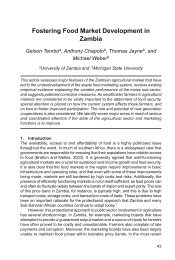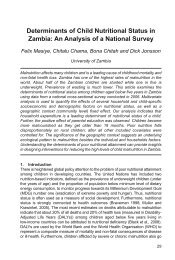Introduction to Basic Legal Citation - access-to-law home
Introduction to Basic Legal Citation - access-to-law home
Introduction to Basic Legal Citation - access-to-law home
Create successful ePaper yourself
Turn your PDF publications into a flip-book with our unique Google optimized e-Paper software.
Grand Central Station or the waiting room of a small <strong>to</strong>wn rail depot served as a meeting<br />
place for people going about their daily business, it was because the rest of the community<br />
was a sidewalk's width away. See H. Roger Grant & Charles H. Bohi, The Country Railroad<br />
Station in America 8-9 (1978); William D. Middle<strong>to</strong>n, Grand Central 109 (1978). Clearly, the<br />
same is not true of the Port Authority's air terminals. Although two people in Mid<strong>to</strong>wn<br />
Manhattan might agree <strong>to</strong> meet "under the golden clock" of Grand Central Terminal whether<br />
or not they were going <strong>to</strong> take a train, see William D. Middle<strong>to</strong>n, Grand Central 109 (1978),<br />
it is highly unlikely that two people who had no intention of taking air flights would agree <strong>to</strong><br />
meet at any of the Port Authority airports.<br />
Moreover, contrary <strong>to</strong> Plaintiff's assertions, as an his<strong>to</strong>rical matter, it is far from clear that rail<br />
stations and terminals served as public fora in the First Amendment sense. Plaintiffs fail <strong>to</strong><br />
document that solicitation and distribution of literature actually occurred at railroad terminals.<br />
Plaintiffs also ignore the fact that railroad terminals were privately owned, and, therefore, any<br />
solicitation or distribution of literature which <strong>to</strong>ok place was at the pleasure of the private<br />
entities which owned the terminals. See generally United Transp. Union v. Long Island R.R.,<br />
455 U.S. 678, 686 (1982); H. Roger Grant & Charles H. Bohi, The Country Railroad Station<br />
in America 11-15 (1978).(22)<br />
The distribution of literature has similar effects on pedestrian flow. Air passengers must alter<br />
their path <strong>to</strong> avoid the distribu<strong>to</strong>r, or pause <strong>to</strong> take literature and perhaps s<strong>to</strong>p <strong>to</strong> read it or <strong>to</strong><br />
throw it in a wastebin. Significantly, Plaintiff's themselves concede that "literature distribution<br />
. . . might well be as disruptive <strong>to</strong> a traveller 'hurrying <strong>to</strong> catch a plane or <strong>to</strong> arrange ground<br />
transportation' as a request for a voluntary donation." Petition for Writ of Certiorari at 22<br />
(citation omitted). And, of course, if Plaintiffs were entitled <strong>to</strong> engage in such activity, others<br />
would have the right <strong>to</strong> do so as well. As noted by this Court in Heffron v. ISKCON, "The<br />
inquiry must not only involve ISKCON, but all other organizations that would be entitled <strong>to</strong><br />
distribute, sell or solicit if the . . . rule may not be enforced with respect <strong>to</strong> ISKCON." 452<br />
U.S. 640, 654 (1981); accord Clark v. Community for Creative Non-Violence, 468 U.S. 288,<br />
296-97 (1984).<br />
It is well established that even in a public forum, the government is not powerless <strong>to</strong> regulate<br />
First Amendment activity. Although it is true that all communication may not be excluded<br />
from a public forum, content-neutral regulations may be enforced if they are reasonable and<br />
narrowly tailored <strong>to</strong> serve significant governmental interests, and leave open ample alternative<br />
channels of communication. E.g., Perry Educ. Ass'n v. Perry Local Educa<strong>to</strong>rs' Ass'n, 460<br />
U.S. at 46; Clark, 468 U.S. at 293. The Port Authority's restriction of solicitation and<br />
distribution of literature <strong>to</strong> sidewalks adjacent <strong>to</strong> air terminal buildings satisfies this test.<br />
Adapted from Children of Bedford, Inc. v. Petromelis, 77 N.Y.2d 713, 726-727, 573<br />
N.E.2d 541, 553, 570 N.Y.S.2d 453, 464 (1991), vacated, 112 S.Ct. 859 (1991).<br />
If the only purpose of section 632-a was <strong>to</strong> compensate victims, however, petitioners'<br />
contention that the State's needs could be met by other, less burdensome means would be<br />
more persuasive. Manifestly, article 22 and the general civil procedures address that need.<br />
Section 632-a provides not only a method for victims <strong>to</strong> obtain compensation, however, it also<br />
meets other compelling governmental interests. First, it preserves the victim's equitable right<br />
<strong>to</strong> assets earned by a criminal as a result of the victimization. Compare Executive Law 631<br />
144




